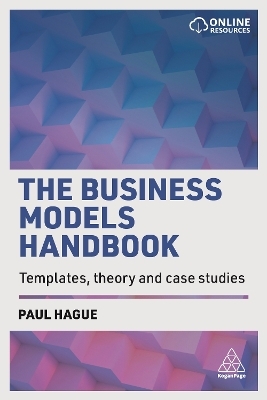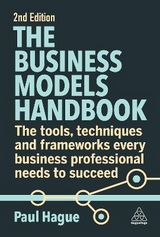
The Business Models Handbook
Kogan Page Ltd (Verlag)
978-0-7494-8187-2 (ISBN)
Enhance your business and marketing planning and overcome common challenges, with this collection of the most valuable and reliable business frameworks and models.
Business frameworks sit at the heart of every successful business. They add structure and clarity to business problems and can help practitioners overcome the everyday challenges they face. The Business Models Handbook brings together the most helpful and widely used templates and frameworks into a single, invaluable resource. Each chapter focuses on an individual business framework, giving an overview of 50 of the best known frameworks and how it will help an organization grow and be profitable. Each supported by a real-world case study, these include ANSOFF matrix, Price-Quality-Strategy model, Stage-Gate model, Service Profit Chain and many more.
Authored by a leading global market researcher with a background working on over 3,000 different research projects, The Business Models Handbook is an invaluable resource for any student or professional. Online resources include lecture slides that align with each chapter.
Paul Hague is the Founder of B2B International Ltd, a global market research company. He is fellow of the Market Research Society and the author of ten books, sharing 30 years of practical experience in market research and marketing. He is a visiting fellow at Manchester Metropolitan University and a guest lecturer at Manchester Business School. His books have been translated into Italian, Indonesian, Bulgarian, Polish, Portuguese and Chinese.
Chapter - 01: Introduction – An overview of business and marketing models;
Chapter - 02: The 4Ps – How to design your marketing mix;
Chapter - 03: ADL matrix – Strengthening a product portfolio or strategic business units;
Chapter - 04: AIDA – A business model for improving marketing communications;
Chapter - 05: Ansoff matrix – How to grow your company;
Chapter - 06: Benchmarking – Setting targets for business and marketing KPIs;
Chapter - 07: Blue ocean strategy – Kick-starting innovation and new product development;
Chapter - 08: Boston Consulting Group (BCG) matrix – Planning a product portfolio or multiple strategic business units;
Chapter - 09: Brand audit – Improving the strength of a brand;
Chapter - 10: Competitive intelligence – Assessing market strengths and weaknesses;
Chapter - 11: Conjoint analysis – Assessing optimum pricing and the value of component parts;
Chapter - 12: Customer journey maps – Assessing the current performance of marketing and sales processes;
Chapter - 13: Customer lifetime value – Estimating customer spend over their lifetime with the company;
Chapter - 14: Customer value proposition – Creating a compelling purchase motive;
Chapter - 15: Diffusion of innovation – Launching new products and services;
Chapter - 16: Directional policy matrix – How to prioritize segments or new ideas;
Chapter - 17: Disruptive innovation model – Identifying unique ways of beating the competition;
Chapter - 18: Edward de Bono’s six thinking hats – Brainstorming problems and generating new ideas;
Chapter - 19: EFQM excellence model – Improving an organization’s quality and performance;
Chapter - 20: Four corners – Analysing competitor strategies;
Chapter - 21: Gap analysis – Improving areas of weakness in a company;
Chapter - 22: Greiner’s growth model – Recognition and transition through different phases of company growth;
Chapter - 23: Kano model – Identifying purchase motivations;
Chapter - 24: Kotler’s five product levels – Adding value to a product or service;
Chapter - 25: Market sizing – Assessing the size and value of a served or potential market;
Chapter - 26: Maslow’s hierarchy – Differentiating market positioning;
Chapter - 27: McKinsey 7S – A company ‘health check’ audit tool;
Chapter - 28: Mintzberg’s 5Ps for strategy – Devising a competitive strategy;
Chapter - 29: MOSAIC – Setting objectives for current and potential opportunities and how to reach them;
Chapter - 30: Net Promoter Score® – A tool for driving customer excellence;
Chapter - 31: New product pricing (Gabor–Granger and van Westendorp) – Pricing new products;
Chapter - 32: Personas – Improving the focus of marketing messages;
Chapter - 33: PEST – Assessing four major macro factors that shape a company’s future;
Chapter - 34: Porter’s five forces – Assessing five economic factors for competitive intensity;
Chapter - 35: Porter’s generic strategies – Pinpointing the strongest competitive position;
Chapter - 36: Price elasticity – Outlining opportunities for raising or lowering prices;
Chapter - 37: Price quality strategy – Guiding a company’s pricing strategy;
Chapter - 38: Product life cycle – Determining a long-term product strategy;
Chapter - 39: Product service positioning matrix – Positioning products according to quality and service value;
Chapter - 40: Segmentation – Using customer groups to gain competitive advantage;
Chapter - 41: Service profit chain – Connecting employee satisfaction and performance with company profits;
Chapter - 42: SERVQUAL – Aligning customer expectations and company performance;
Chapter - 43: SIMALTO – Identifying the customer value placed on product or service improvements;
Chapter - 44: Stage gate new product development – Planning the development and launch of new products and services;
Chapter - 45: SWOT analysis – Analysing growth opportunities at product, team or business level;
Chapter - 46: System 1 and System 2 thinking – Identifying the emotional forces that drive decisions;
Chapter - 47: USP – Pinpointing the unique selling point of a product or service;
Chapter - 48: Value-based marketing – Adding value to products and services to improve profitability;
Chapter - 49: Value chain – Identifying product or service value during the manufacturing process;
Chapter - 50: Value equivalence line – Managing price and product benefits in a business strategy;
Chapter - 51: Value net – How to benefit from competitor collaboration
| Erscheinungsdatum | 27.12.2018 |
|---|---|
| Verlagsort | London |
| Sprache | englisch |
| Maße | 155 x 235 mm |
| Gewicht | 525 g |
| Themenwelt | Wirtschaft ► Betriebswirtschaft / Management ► Marketing / Vertrieb |
| Wirtschaft ► Betriebswirtschaft / Management ► Unternehmensführung / Management | |
| ISBN-10 | 0-7494-8187-0 / 0749481870 |
| ISBN-13 | 978-0-7494-8187-2 / 9780749481872 |
| Zustand | Neuware |
| Haben Sie eine Frage zum Produkt? |
aus dem Bereich



